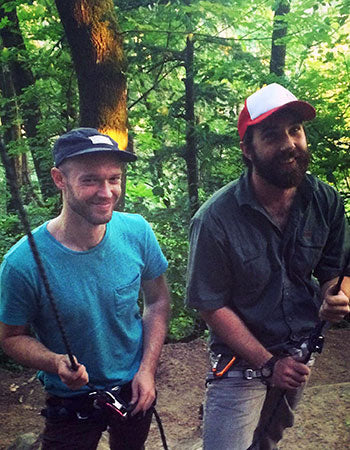
Climbing Ropes: Which rope is right for you?
Which rope you should select depends entirely on what sort of climbing you expect to be doing. Every climbing rope you should consider buying is tested and certified by the UIAA and will have some similar information available about it. Let’s look at that info first.
I use the Trango Lotus 9.9 as an example
*Some categories show results from UIAA lab tests and should be used to compare ropes to each other, not to predict how a rope will behave in real life. Lab tests are designed to eliminate factors that you cannot and should not try to eliminate at the crag.
Rope Type
Single
“Single” refers to any rope that can be used on its own to climb on rock. Half and Twin ropes are also available and are designed to be used in pairs, although halves are sometimes used independently on snow. If you’re not sure what you need, stick with a single. The UIAA certifies each rope as a single, half and/or twin and uses a different test for each category.
Length
70 meters
Most modern climbing ropes are 60m or 70m. 70m means a little more peace of mind on long routes and the option to cut off the ends when they get worn (most wear and tear happens in the last 5m of the rope). 60M saves weight and money. 40m is for the gym.
Diameter
9.9mm
Single ropes range from 8.9mm to 11mm or more, but most folks climb on ropes in the 9.2 – 10.2 range. The cores of single ropes are all pretty much equal: a larger diameter means a thicker sheath, increased durability, and increased weight. It’s worth noting that belay devices work better with some ropes than others, so check their manufacturers’ recommendations.
*Static Elongation
9.4%
How much the rope will stretch when a standardized weight is applied it while it hangs straight. 176lbs for single ropes.
*Dynamic Elongation
34%
How much the rope stretches during the UIAA’s drop test, which is designed to represent just about the worst possible fall that could happen.
*Impact Force
7.9kN
The amount of force generated at the worst moment of the UIAA drop test. A Kilonewton (kN) is equivalent to about 225 lbs and is measurement of force, not weight.
*UIAA falls
7
This is the number of times the impossibly harsh UIAA drop test can be repeated at short intervals before the rope breaks, it is NOT the number falls the rope can withstand. You could take hundreds of gentler falls on your rope if it is maintained properly. This number loosely indicates the rope’s durability against falls and should only be used for comparison between ropes.
Dry Treatment
Sheath Dry
Dry treatments protect the ropes fibers from absorbing water, which dramatically weakens the rope. Treatments also help repel dust and grit which can wear down your rope over time. Some ropes have no treatment, making them more affordable, and they still work fine if they’re kept clean. Sheath treatment is helpful for just about anyone climbing outside, and core treatment is essential if your rope might get wet (think long routes in thunderstorm country or roping up to cross a glacier).
Midpoint
Center Mark
Most ropes either have a center mark which is dyed into the rope or are bi-pattern, meaning each half of the rope looks different. Center marks are used to prevent feeding out more rope than is needed to lower a climber, or to center the rope for a rappel. DO NOT use tape to mark the center of your rope, the adhesive breaks down and the tape may slide. This has been linked to at least one fatality in recent years.
Most climbers buy their first rope for one of two reasons. 1) They want to start climbing outside and are just getting into the sport or 2) They climb in the gym on top rope and want to start leading. Let’s look at these two examples first, then explore additional options in 3).
1) For new outdoor climbers most of the climbing you’ll be doing is top-roping, and as you get into leading you likely won’t be pushing hard grades right off the bat. For this reason, I recommend a 60m or a 70m rope with at least a 9.5mm diameter. 9.8mm to 10.2mm is ideal, although compatibility with belay devices starts to become an issue with larger diameter ropes. Sheath dry treatment is a big plus and will pay for itself in increased longevity. For these applications, I prefer a center mark to a bi-pattern rope since it’s usually easier to notice as the belayer and will save you a bunch of cash. The UIAA specific specs will all be similar for this type of rope and you likely won’t be able to tell the difference in the field.
2) Gym-specific ropes are available and usually come in 40m length and 9.8mm-10mm diameters, which is perfect. No treatment is really needed since you won’t (or at least shouldn’t) be using your gym rope outside. A great way to save a few bucks on a gym rope is to ask around for another person interested in purchasing a rope for the gym and splitting the cost of a 70m rope with similar specs. Currently, every gym here in Portland, OR, is okay with a 35m rope but check with your local gym if their walls are exceptionally tall. Feel free to come into Next Adventure and we’ll be happy to help you cut your rope.
3) If you’re interested in mountaineering or long alpine climbs you may need to consider a lighter rope, or even halves or doubles. Having two ropes makes long retreats much easier, are safer when rock fall or crampon punctures are a concern and save weight over many beefy single ropes. Many mountaineers carry one 30m half rope to protect against crevasse falls or to top-belay less experienced climbers up short technical pitches, preferring them for their limited elongation. Twins are designed to be clipped into each piece of pro together and catch a fall together, so they are much more dynamic and are ideal for long bolted routes like those found in Verdon, France. They are uncommon in the states. When I climb long rock routes I use a 70m, 9.2mm fully dry treated rope and am very, very happy with it. Climbers who are especially weight conscious may also choose thinner ropes, at the cost of durability.
There is one other kind of rope available for climbers, called static line. It is meant for hauling, jugging (ascending the rope, not the rock) and industrial applications. Chances are that unless you’re positive you need it, then you don’t need it. Using static line as a climbing rope is very dangerous since it doesn’t absorb force.
I hope this has helped you understand climbing ropes a little better or at least made the process of choosing a rope a little less daunting. If you’re in the Portland area swing by next adventure to check out our wide selection of ropes and other climbing gear, or just to say hi! If you have any questions or feedback for me I’m available at hanrahan.matt@gmail.com.
Read all of Matt's Dirtbag Adventures!
 Me trying to some sleep in Rumney, NH. I’d forgotten a pillow and used my rope as a substitute. It worked fine until Casey’s flash woke me up!
Me trying to some sleep in Rumney, NH. I’d forgotten a pillow and used my rope as a substitute. It worked fine until Casey’s flash woke me up!
 Next Adventure staffer David Keliher and I at Broughton’s Bluff a few years ago, using a 10mm+ rope that was perfect for low angle top roping. Luckily, the routes were so short we were both able to belay off the same rope!
Next Adventure staffer David Keliher and I at Broughton’s Bluff a few years ago, using a 10mm+ rope that was perfect for low angle top roping. Luckily, the routes were so short we were both able to belay off the same rope!
 My friend Jeff is using a 8.7 half rope to practice rappelling off of a snow anchor in The Tetons last summer.
My friend Jeff is using a 8.7 half rope to practice rappelling off of a snow anchor in The Tetons last summer.

